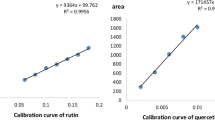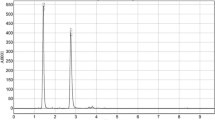Abstract
In the current study, a simple, rapid reversed phase high performance liquid chromatographic (RP- HPLC) method was developed and validated for evaluation of wedelolactone in Eclipta alba, an indigenous medicinal herb commonly known as Bhringaraj. Wedelolactone was quantified in the dried root, stem, leaves, flowers and whole plant of E. alba by a gradient RP-HPLC procedure with buffer (1 mM potassium dihydrogen phosphate—KH2PO4) and acetonitrile as mobile phase and separation was carried out on CAPCELL PAK C18 (SHISEIDO) column at a flow rate of 1.5 mL/min and UV detection at 351 nm using photodiode array detector (PDA). The method was validated as per ICH Q2 (R1) (International Conference on Harmonization of Technical Requirements for the Registration of Pharmaceuticals for Human Use) guidelines for various analytical method validation parameters such as linearity, accuracy, specificity, precision, and sensitivity (limit of detection and limit of quantification). The precision of the method was confirmed by a relative standard deviation < 2.0% (n = 6), and wedelolactone recovery was observed between 99.5 and 103.6%. The LOD was found to be 0.084 µg/mL and the LOQ was 0.25 µg/mL, and the response was linear from 2.5 to 140 µg/mL with excellent correlation coefficient (R2) of 0.9997. The study also revealed that variation for the content of wedelolactone among accessions and between different plant parts, the highest content is found in the leaves. The developed method is precise, sensitive, accurate, reproducible and can be used for the quantitative estimation of wedelolactone in E. alba plant material.








Similar content being viewed by others
Abbreviations
- RP-HPLC:
-
Reverse Phase High Performance Liquid chromatography
- PDA:
-
Photodiode array detector
- LOD:
-
Limit of detection
- LOQ:
-
Limit of quantification
References
Alagumanivasagam G, Veeraman P (2013) A review on medicinal plants with potentialhypolipidemic activity. Int J Pharm Anal Res 4:129–134
Aziz S, Ganaie MA (2017) Assessment of ethanol and Eclipta alba L. extract on haematological parameters on liver of Rattus rattus. Pharm Innovation J 6:671–675
Boligon AA, Athayde ML (2014) Importance of HPLC in analysis of plant extracts. Austin Chromatogr 1:2
Chokotia L, Vashistha P, Sironiya R, Matoli H (2013) Pharmacological Activities of Eclipta alba (L.). Int J Res Dev Pharm l Sci 2:499–502
Chopra RN, Chopra IC, Nayar SL (2008) Glossary of Indian Medicinal Plants. New Delhi: CSIR. 1956: 66-7
CH-Q2A. Validation of analytical procedures: methodology, Harmonized Tripartite Guideline prepared within the International Conference on Harmonization of Technical Requirements for the Registration of Pharmaceuticals for Human Use, Geneva. 1996
Dalal S, Kataria SK, Sastry KV, Rana SVS (2010) Phytochemical screening of methanolic extract and antibacterial activity of active principles of hepatoprotective herb, Eclipta alba. Ethnobotanical Leaflets 3:248–258
Dhandapani R (2007) Hypolipidemic activity of Eclipta prostrata (L.) L leaf extract in atherogenic diet induced hyperlipidemic rats. Indian J Exp Biol 45:617–619
Hamrapurkar P, Chachad M, Phale M (2009) Quantitative estimation of wedelolactone in Eclipta alba Hask using high performance liquid chromatography. Nat Prod Indian J 5:57–60
Handa SS, Sharma A, Chakarborty KK (1986) Natural Products and Plants as Liver Protecting Drugs. Fitoterapia 57:307–351
Jadhav VM, Thorat RM, Kadam VJ, Salaskar KP (2009) Chemical composition, pharmacological activities of Eclipta alba. J Pharm Res 2:1229–1231
Kirtikar KR, Basu BD (1999) Indian medicinal plants, Deharadun (India): International book distributors
Kobori M, Yang Z, Gong D, Heissmeyer V, Zhu H, Jung YK, Gakidis MA, Rao A, Sekina K, Ikegami F, Yuan C, Yuan J (2004) Wedelolactone suppresses LPS-induced caspase 11 expression by directly inhibiting the IKK complex. Cell Death Differentiation 11:123–130
Kulkarni S, Khatwani P (2011) Optimization of extraction conditions of a sensitive HPTLC method for estimation of wedelolactone in different extracts of Eclipta alba. IJPSDR 3:56–61
Kumar S, Dhanani T (2013) Development and validation of a rapid high performance liquid chromatography-photodiode array detection method for estimation of a bioactive compound wedelolactone in extracts of Eclipta alba. Braz J Pharm Sci 49:57–63
Meenu, Chadha H, Sokindra Kumar, Ajeet (2017) Eclipta Alba, A bunch of Pharmacological Possibilities- a Review. Mod Appl Bioequiv Availab 1 MABB.MS.555576
Mendes FNP, Morais SMD, Silva MGV, Vieira IR, Rodrigues PAS (2014) Determination of wedelolactone and demethylwedelolactone In Eclipta Alba (L) Hassk By HPLC. Int J Pharm Pharm Sci 6(10):403–406
Murali B, Agrawal A, Anand MS, Samiulla DS (2002) Estimation of Wedelolactone and Demethylwedelolactone In Eclipta alba Hassk by improved chromatographic analysis. J Nat Remedies 2:99–101
Panchal, AH, Patel RK, Pundarikakshudu K and Anil B (2012) Evalaution of anti-inflammatory activities of extract of Leves of Ecliptaalba and Wedeliacalendulacea Int J Pharmaceut Sci 1846–1852
Patel MB, Mishra SHA (2006) Simple spectrofluorometric estimation of wedelolactone in methanol extract of Eclipta alba. Pharmacogn Mag 2:168–171
Patel MB, Kadakia VM, Mishra SH (2008) Simultaneous estimation of andrographolide and wedelolactone in herbal formulations. Ind J Pharmaceut Sci 70:689–693
Patel M, Verma R, Srivastav P (2016) Antioxidant activity of Eclipta alba extract. J Med Plants Stud 4:92–98
Pereira NA, Pereira BMR, Nascimento MC, Parente JP, Mors WB (1994) Pharmacological screening of plants recommended by folk medicine as snake venom antidotes; IV- protection against Jararaca venom by isolated constituents. Planta Med 60:99–100
Q2A, ICH, Q2 (R1). Validation of Analytical Procedures: Text and Methodology International Conference on Harmonization, Geneva, (http://www.ich.org/LOB/media/MEDIA417.pdf). 2005
Rai P, Mishra SH (2007) Development of a simple and sensitive spectrophotometric method for the simultaneous determination of asiaticoside and wedelolactone in a polyherbal formulation. Pharmacogn Mag 3:47–51
Rastogi RP, Mehrotra BN (1991) Compendium of India Medicinal Plants, Vol. II. New Delhi, India, Publications and Information Directorate (CSIR), p. 288
Sagar BPS, Panwar R, Goswami A, Kadian K, Tyagi K, Chugh M, Dalal S, Zafar R (2006) Pharmacokinetic interactions of Antihepatotoxic wedelolactone with paracetamol in wistar albino rats. Pharm Biol 44:554–561
Sarg TM, Salam NA, El-Domiaty M, Khafagy SM (1981) The Steroid, Triterpenoid and Flavonoid constituents of Eclipta alba (L.) Hassk. (Compositae) grown in Egypt. Sci Pharm 49:262–264
Sarveswaran S, Gautam SC, Gosh J (2012) Wedelolactone, a medicinal plant-derived coumestan, induces caspase-dependent apoptosis in prostate cancer cells via downregulation of PKCε without inhibiting Akt. Int J Oncol 41:2191–2199
Savita K, Prakashchandra K (2011) Optimization of extraction conditions and development of a sensitive HPTLC method for estimation of wedelolactone in different extracts of Eclipta alba. Int J Pharm Sci Drug Res 3:56–61
Saxena AK, Singh B, Anand KK (1993) Hepatoprotective effects of Eclipta alba on subcellular levels in rats. J Ethnopharmacol 40:155–161
Shailajan S, Menon S, Singh D, Swar G (2016) Validated analytical RP HPLC method for quantitation of wedelolactone from Eclipta alba and marketed Ayurvedic formulations. Pharmacogn J 8:2
Sharma M, Yusuf M, Hussain S, Hussain A (2012) Phytochemical constituents and pharmacological activities of Eclipta alba Linn. (Asteraceae): a review. IRJP 3:51–53
Sharma S, Richa and Harsimran (2017) Phytochemical and anatomical screening of Eclipta prostrata L. An important medicinal herb from Chandigarh J Med Plants Stud 5: 255- 25
Sikroria BC, Srivastava SJ, Niranjan GS (1982) Phytochemical studies on Eclipta Alba. J Indian Chem Soc 12:905–909
Simonsen HT, Nordskjold JB, Smitt UW, Nyman U, Palpu P, Joshi P (2001) In vitro screening of Indian medicinal plants for Antiplasmodial activity. J Ethnopharmacol 74:195–204
Singh P, Sharma AK, Joshi KC, Bohlmann FA (1985) Further dithienylacetylene from Eclipta erecta. Phytochemistry 3:615–616
Singh B, Saxena AK, Chandan BK, Agarwal SG, Anand KK (2001) In vivo hepatoprotective activity of active fraction from ethanolic extract of eclipta alba leaves. Indian J Physiol Pharmacol 45:435–441
Thakur VD, Mengi SA (2005) Neuropharmacological Profile of Eclipta alba (Linn.) Hassk. J Ethnopharmacol 102:23–31
Thorat RM, Jadhav VM, Kadam VJ, Kamble SS, Salaskar KP (2009) Development of HPTLC method for estimation of wedelolactone, quercetin and jatamansone in polyherbal formulation. Int J Chem Technol Res 1:1079–1086
Wagner H, Geyer B, Kiso Y, Hikino H, Rao GS (1986) Coumestans as the main active principles of the liver drugs Eclipta alba and Wedellia calendulacea. Planta Med 52:370–374
World Health Organization. WHO Traditional Medicine Strategy 2002–2005
Zafar R, Sagar BPS (1999) In vitro regeneration of Eclipta Alba and increased production of coumestans. Fitoterapia 74:348–356
Acknowledgements
The authors are grateful to the director, ICAR-IIHR, Hesaraghatta, Bangalore for providing necessary facilities and encouragement.
Funding
The authors are very thankful to the financial assistance provided from National Medicinal Plants Board, Department of AYUSH, Ministry of Health and Family Welfare, Govt. of India (Project No: Z.18017/187/CSS/R&D/KR-01/2018–19-NMPB-IVA entitled ‘Collection, characterization and genetic improvement of Eclipta alba’.
Author information
Authors and Affiliations
Corresponding author
Ethics declarations
Conflict of interest
The authors declare that there is no conflict of interest.
Additional information
Publisher's Note
Springer Nature remains neutral with regard to jurisdictional claims in published maps and institutional affiliations.
Rights and permissions
About this article
Cite this article
Kumar, B.A., Rao, V.K., Bindu, K.H. et al. Development, validation and application of RP-HPLC method for quantitative estimation of wedelolactone in different accessions and plant parts of Eclipta alba (L.). J. Plant Biochem. Biotechnol. 31, 788–802 (2022). https://doi.org/10.1007/s13562-021-00721-w
Received:
Accepted:
Published:
Issue Date:
DOI: https://doi.org/10.1007/s13562-021-00721-w




